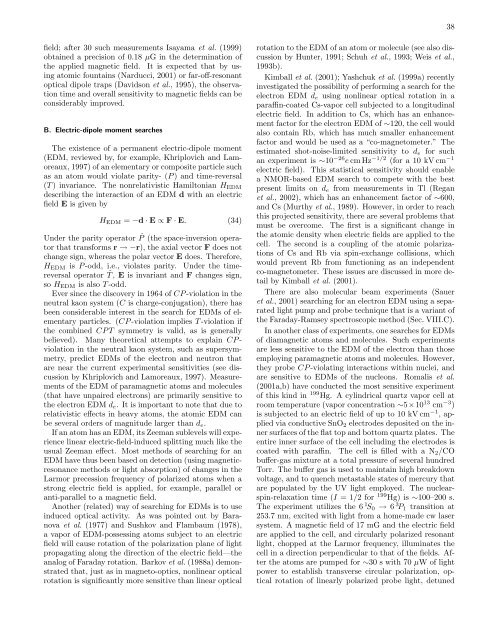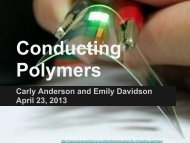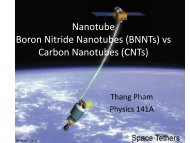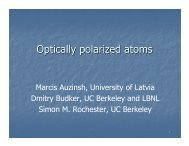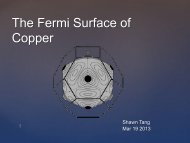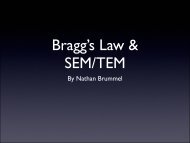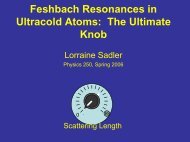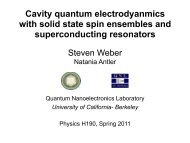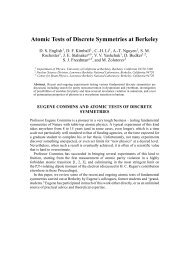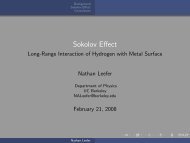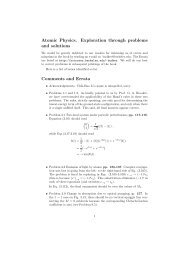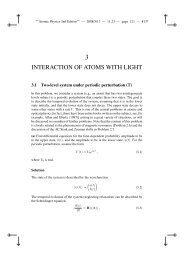Resonant nonlinear magneto-optical effects in atomsâ - The Budker ...
Resonant nonlinear magneto-optical effects in atomsâ - The Budker ...
Resonant nonlinear magneto-optical effects in atomsâ - The Budker ...
Create successful ePaper yourself
Turn your PDF publications into a flip-book with our unique Google optimized e-Paper software.
38<br />
field; after 30 such measurements Isayama et al. (1999)<br />
obta<strong>in</strong>ed a precision of 0.18 µG <strong>in</strong> the determ<strong>in</strong>ation of<br />
the applied magnetic field. It is expected that by us<strong>in</strong>g<br />
atomic founta<strong>in</strong>s (Narducci, 2001) or far-off-resonant<br />
<strong>optical</strong> dipole traps (Davidson et al., 1995), the observation<br />
time and overall sensitivity to magnetic fields can be<br />
considerably improved.<br />
B. Electric-dipole moment searches<br />
<strong>The</strong> existence of a permanent electric-dipole moment<br />
(EDM, reviewed by, for example, Khriplovich and Lamoreaux,<br />
1997) of an elementary or composite particle such<br />
as an atom would violate parity- (P ) and time-reversal<br />
(T ) <strong>in</strong>variance. <strong>The</strong> nonrelativistic Hamiltonian H EDM<br />
describ<strong>in</strong>g the <strong>in</strong>teraction of an EDM d with an electric<br />
field E is given by<br />
H EDM = −d · E ∝ F · E. (34)<br />
Under the parity operator ˆP (the space-<strong>in</strong>version operator<br />
that transforms r → −r), the axial vector F does not<br />
change sign, whereas the polar vector E does. <strong>The</strong>refore,<br />
H EDM is P -odd, i.e., violates parity. Under the timereversal<br />
operator ˆT , E is <strong>in</strong>variant and F changes sign,<br />
so H EDM is also T -odd.<br />
Ever s<strong>in</strong>ce the discovery <strong>in</strong> 1964 of CP -violation <strong>in</strong> the<br />
neutral kaon system (C is charge-conjugation), there has<br />
been considerable <strong>in</strong>terest <strong>in</strong> the search for EDMs of elementary<br />
particles. (CP -violation implies T -violation if<br />
the comb<strong>in</strong>ed CP T symmetry is valid, as is generally<br />
believed). Many theoretical attempts to expla<strong>in</strong> CP -<br />
violation <strong>in</strong> the neutral kaon system, such as supersymmetry,<br />
predict EDMs of the electron and neutron that<br />
are near the current experimental sensitivities (see discussion<br />
by Khriplovich and Lamoreaux, 1997). Measurements<br />
of the EDM of paramagnetic atoms and molecules<br />
(that have unpaired electrons) are primarily sensitive to<br />
the electron EDM d e . It is important to note that due to<br />
relativistic <strong>effects</strong> <strong>in</strong> heavy atoms, the atomic EDM can<br />
be several orders of magnitude larger than d e .<br />
If an atom has an EDM, its Zeeman sublevels will experience<br />
l<strong>in</strong>ear electric-field-<strong>in</strong>duced splitt<strong>in</strong>g much like the<br />
usual Zeeman effect. Most methods of search<strong>in</strong>g for an<br />
EDM have thus been based on detection (us<strong>in</strong>g magneticresonance<br />
methods or light absorption) of changes <strong>in</strong> the<br />
Larmor precession frequency of polarized atoms when a<br />
strong electric field is applied, for example, parallel or<br />
anti-parallel to a magnetic field.<br />
Another (related) way of search<strong>in</strong>g for EDMs is to use<br />
<strong>in</strong>duced <strong>optical</strong> activity. As was po<strong>in</strong>ted out by Baranova<br />
et al. (1977) and Sushkov and Flambaum (1978),<br />
a vapor of EDM-possess<strong>in</strong>g atoms subject to an electric<br />
field will cause rotation of the polarization plane of light<br />
propagat<strong>in</strong>g along the direction of the electric field—the<br />
analog of Faraday rotation. Barkov et al. (1988a) demonstrated<br />
that, just as <strong>in</strong> <strong>magneto</strong>-optics, <strong>nonl<strong>in</strong>ear</strong> <strong>optical</strong><br />
rotation is significantly more sensitive than l<strong>in</strong>ear <strong>optical</strong><br />
rotation to the EDM of an atom or molecule (see also discussion<br />
by Hunter, 1991; Schuh et al., 1993; Weis et al.,<br />
1993b).<br />
Kimball et al. (2001); Yashchuk et al. (1999a) recently<br />
<strong>in</strong>vestigated the possibility of perform<strong>in</strong>g a search for the<br />
electron EDM d e us<strong>in</strong>g <strong>nonl<strong>in</strong>ear</strong> <strong>optical</strong> rotation <strong>in</strong> a<br />
paraff<strong>in</strong>-coated Cs-vapor cell subjected to a longitud<strong>in</strong>al<br />
electric field. In addition to Cs, which has an enhancement<br />
factor for the electron EDM of ∼120, the cell would<br />
also conta<strong>in</strong> Rb, which has much smaller enhancement<br />
factor and would be used as a “co-<strong>magneto</strong>meter.” <strong>The</strong><br />
estimated shot-noise-limited sensitivity to d e for such<br />
an experiment is ∼10 −26 e cm Hz −1/2 (for a 10 kV cm −1<br />
electric field). This statistical sensitivity should enable<br />
a NMOR-based EDM search to compete with the best<br />
present limits on d e from measurements <strong>in</strong> Tl (Regan<br />
et al., 2002), which has an enhancement factor of ∼600,<br />
and Cs (Murthy et al., 1989). However, <strong>in</strong> order to reach<br />
this projected sensitivity, there are several problems that<br />
must be overcome. <strong>The</strong> first is a significant change <strong>in</strong><br />
the atomic density when electric fields are applied to the<br />
cell. <strong>The</strong> second is a coupl<strong>in</strong>g of the atomic polarizations<br />
of Cs and Rb via sp<strong>in</strong>-exchange collisions, which<br />
would prevent Rb from function<strong>in</strong>g as an <strong>in</strong>dependent<br />
co-<strong>magneto</strong>meter. <strong>The</strong>se issues are discussed <strong>in</strong> more detail<br />
by Kimball et al. (2001).<br />
<strong>The</strong>re are also molecular beam experiments (Sauer<br />
et al., 2001) search<strong>in</strong>g for an electron EDM us<strong>in</strong>g a separated<br />
light pump and probe technique that is a variant of<br />
the Faraday-Ramsey spectroscopic method (Sec. VIII.C).<br />
In another class of experiments, one searches for EDMs<br />
of diamagnetic atoms and molecules. Such experiments<br />
are less sensitive to the EDM of the electron than those<br />
employ<strong>in</strong>g paramagnetic atoms and molecules. However,<br />
they probe CP -violat<strong>in</strong>g <strong>in</strong>teractions with<strong>in</strong> nuclei, and<br />
are sensitive to EDMs of the nucleons. Romalis et al.<br />
(2001a,b) have conducted the most sensitive experiment<br />
of this k<strong>in</strong>d <strong>in</strong> 199 Hg. A cyl<strong>in</strong>drical quartz vapor cell at<br />
room temperature (vapor concentration ∼5×10 13 cm −3 )<br />
is subjected to an electric field of up to 10 kV cm −1 , applied<br />
via conductive SnO 2 electrodes deposited on the <strong>in</strong>ner<br />
surfaces of the flat top and bottom quartz plates. <strong>The</strong><br />
entire <strong>in</strong>ner surface of the cell <strong>in</strong>clud<strong>in</strong>g the electrodes is<br />
coated with paraff<strong>in</strong>. <strong>The</strong> cell is filled with a N 2 /CO<br />
buffer-gas mixture at a total pressure of several hundred<br />
Torr. <strong>The</strong> buffer gas is used to ma<strong>in</strong>ta<strong>in</strong> high breakdown<br />
voltage, and to quench metastable states of mercury that<br />
are populated by the UV light employed. <strong>The</strong> nuclearsp<strong>in</strong>-relaxation<br />
time (I = 1/2 for 199 Hg) is ∼100–200 s.<br />
<strong>The</strong> experiment utilizes the 6 1 S 0 → 6 3 P 1 transition at<br />
253.7 nm, excited with light from a home-made cw laser<br />
system. A magnetic field of 17 mG and the electric field<br />
are applied to the cell, and circularly polarized resonant<br />
light, chopped at the Larmor frequency, illum<strong>in</strong>ates the<br />
cell <strong>in</strong> a direction perpendicular to that of the fields. After<br />
the atoms are pumped for ∼30 s with 70 µW of light<br />
power to establish transverse circular polarization, <strong>optical</strong><br />
rotation of l<strong>in</strong>early polarized probe light, detuned


